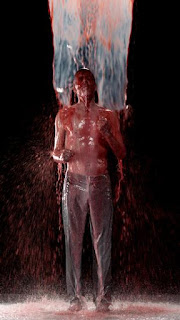 Finding secondary research for my project was fairly easy as I used Pinterest for the large majority of it, however I did gather books from the library and used their images. As the theme of my project isn't something you see everyday, it wasn’t easy to gather primary research, although when not having any luck finding an exhibition which shows something of my theme, I was shown real animal skulls of all varieties and sorts at college. I used the images that I had taken from these to draw from, stitch into and also use some on my piece. The artists of which I studied and took influence from, I found through Pinterest via a piece of their work. My research was a massive part to the development of my project, especially my primary research as it was a lot more specific than my secondary or contextual since I could take my own images. My primary research influenced my final piece as a lot of detail is shown within the pictures I took, this then gave me the idea to stitch the detail into the canvas.
Finding secondary research for my project was fairly easy as I used Pinterest for the large majority of it, however I did gather books from the library and used their images. As the theme of my project isn't something you see everyday, it wasn’t easy to gather primary research, although when not having any luck finding an exhibition which shows something of my theme, I was shown real animal skulls of all varieties and sorts at college. I used the images that I had taken from these to draw from, stitch into and also use some on my piece. The artists of which I studied and took influence from, I found through Pinterest via a piece of their work. My research was a massive part to the development of my project, especially my primary research as it was a lot more specific than my secondary or contextual since I could take my own images. My primary research influenced my final piece as a lot of detail is shown within the pictures I took, this then gave me the idea to stitch the detail into the canvas.
I think I have used visual language in a limited form within my work, however my pencil sheetwork and embroidery pieces both show evidence from shape, form, value, colour and pattern. tI have used a wide range of practical skills and methods within my project as a large part of my was embroidery; I also used pencil work within my sketchbook and sheetwork. As a large majority of my sketchbook/ project was purely detailed pencil drawings, I produced lots of quick
30 second drawings in pen to show my understanding of the criteria and to show diversity. I think one of my biggest difficulties was using the sewing machine; although it is known that practise makes perfect, no matter how much I practise I could never control the foot pedal. I planned up to my final piece by producing experiments such as the sewing machine and different sewing techniques. I also produced a ‘Final Piece Preparation’ sewn sketchbook to show a few processes in a photographic form. I think I could have definitely managed my time better through this project and also shared it efficiently to pieces of work which may have needed more attention, for example my final piece. I have reviewed my progress throughout this by producing simple blog posts and annotations which show thoughts and processes. My inspiration to use embroidery within my project was Eliza Bennett; for a while, I have admired how she uses embroidery( a term that is popularly known as old-fashioned, in an original and controversial way. I think I succeeded various parts of my project proposal although the majority of my ideas changed shortly after I had written it. In my exhibition, I plan to present my final piece and 3 pieces of A2 sheetwork, each piece showing my abilities as an artist. I have prepared for my pecha kucha presentation by producing a powerpoint including 20 images which individually show my skills and processes through this project.
30 second drawings in pen to show my understanding of the criteria and to show diversity. I think one of my biggest difficulties was using the sewing machine; although it is known that practise makes perfect, no matter how much I practise I could never control the foot pedal. I planned up to my final piece by producing experiments such as the sewing machine and different sewing techniques. I also produced a ‘Final Piece Preparation’ sewn sketchbook to show a few processes in a photographic form. I think I could have definitely managed my time better through this project and also shared it efficiently to pieces of work which may have needed more attention, for example my final piece. I have reviewed my progress throughout this by producing simple blog posts and annotations which show thoughts and processes. My inspiration to use embroidery within my project was Eliza Bennett; for a while, I have admired how she uses embroidery( a term that is popularly known as old-fashioned, in an original and controversial way. I think I succeeded various parts of my project proposal although the majority of my ideas changed shortly after I had written it. In my exhibition, I plan to present my final piece and 3 pieces of A2 sheetwork, each piece showing my abilities as an artist. I have prepared for my pecha kucha presentation by producing a powerpoint including 20 images which individually show my skills and processes through this project.
Overall, i think my work has improved from past units, especially since I felt free to experiment with new techniques such as embroidery. I think this is because the term structure has such a wide range of opinions and areas to explore and study.














































